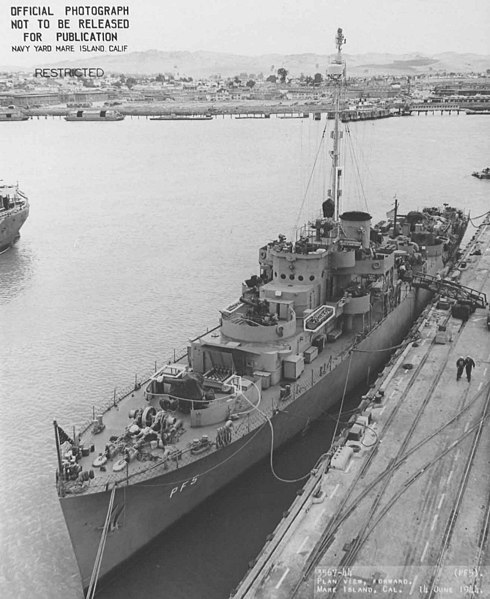Project Hula was a program during World War II in which the United States transferred naval vessels to the Soviet Union in anticipation of the Soviets eventually joining the war against Japan, specifically in preparation for planned Soviet invasions of southern Sakhalin and the Kuril islands. Based at Cold Bay in the Territory of Alaska, the project was active during the spring and summer of 1945. It was the largest and most ambitious transfer program of World War II.
Fort Randall at Cold Bay, Territory of Alaska, in 1942. Project Hula took place here in 1945. The head of the bay itself is at center right.
The Tacoma-class patrol frigate USS Hoquiam (PF-5) at Mare Island Navy Yard, Vallejo, California, on 14 June 1944. Transferred at Cold Bay, on 16 August 1945, she became EK-13 in the Soviet Navy, and was returned to the United States in 1949. The patrol frigates were the largest, most heavily armed, and most expensive ships transferred in Project Hula.
The minesweeper USS Admirable (AM-136) was transferred at Cold Bay, on 19 July 1945, becoming T-331 in the Soviet Navy.
Rear Admiral Boris Dmitrievich Popov, commander of the 5th Independent Brigade of Soviet Navy Ships at Cold Bay, cuts a cake while his counterpart, Captain William S. Maxwell (right), commanding officer of U.S. Navy Detachment 3294, at Cold Bay, and overall commander of Project Hula, and members of their staffs look on during a party in Popov's honor on Memorial Day, 30 May 1945, probably at Dutch Harbor.
Cold Bay is a city in Aleutians East Borough, Alaska, United States. As of the 2010 census, the population was 108, but at the 2020 census this had reduced to 50.
Aerial view of Cold Bay taken during the early 21st century. Cold Bay Airport's runways are visible.





